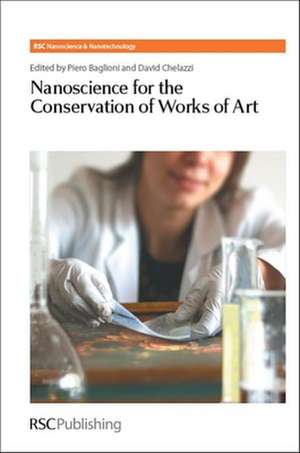Nanoscience for the Conservation of Works of Art: RSC Nanoscience & Nanotechnology, cartea 28
Paul O'Brien, Ralph Nuzzo, Harry Kroto Editat de Piero Baglioni, David Chelazzien Limba Engleză Hardback – 2 iun 2013
Techniques based on nanotechnology are replacing traditional treatments. Scientists expanding their activities to conservation need to be acquainted with these advanced conservation methodologies through a suitable theoretical introduction to systems such as nanoparticles, microemulsions and gels. This unique book provides the detailed information necessary to understand and how to produce and use the modern systems for conservation. Numerous case studies will show how to handle these systems.
Practitioners in cultural heritage activities and conservation science including scientists and conservators that operate in museums, universities, schools, and other institutions, as well as students, will find this book extremely useful. It also appeal to students in surface/colloid chemistry and nanoscience since it offers interesting practical applications to these fundamental sciences.
Din seria RSC Nanoscience & Nanotechnology
- 14%
 Preț: 943.44 lei
Preț: 943.44 lei - 14%
 Preț: 1382.07 lei
Preț: 1382.07 lei - 14%
 Preț: 1230.53 lei
Preț: 1230.53 lei - 14%
 Preț: 943.44 lei
Preț: 943.44 lei - 14%
 Preț: 778.71 lei
Preț: 778.71 lei - 14%
 Preț: 1043.67 lei
Preț: 1043.67 lei - 14%
 Preț: 1118.52 lei
Preț: 1118.52 lei - 14%
 Preț: 1204.00 lei
Preț: 1204.00 lei - 14%
 Preț: 1196.74 lei
Preț: 1196.74 lei - 14%
 Preț: 1191.46 lei
Preț: 1191.46 lei - 14%
 Preț: 1159.76 lei
Preț: 1159.76 lei - 14%
 Preț: 1242.19 lei
Preț: 1242.19 lei - 14%
 Preț: 1157.61 lei
Preț: 1157.61 lei - 14%
 Preț: 1360.94 lei
Preț: 1360.94 lei - 14%
 Preț: 1266.87 lei
Preț: 1266.87 lei - 14%
 Preț: 1123.16 lei
Preț: 1123.16 lei - 14%
 Preț: 1353.49 lei
Preț: 1353.49 lei - 14%
 Preț: 1273.68 lei
Preț: 1273.68 lei - 14%
 Preț: 1307.70 lei
Preț: 1307.70 lei - 14%
 Preț: 1383.21 lei
Preț: 1383.21 lei - 14%
 Preț: 1386.51 lei
Preț: 1386.51 lei - 14%
 Preț: 1088.21 lei
Preț: 1088.21 lei - 14%
 Preț: 1089.02 lei
Preț: 1089.02 lei - 14%
 Preț: 682.86 lei
Preț: 682.86 lei - 14%
 Preț: 948.40 lei
Preț: 948.40 lei - 14%
 Preț: 1027.31 lei
Preț: 1027.31 lei - 14%
 Preț: 948.87 lei
Preț: 948.87 lei - 14%
 Preț: 950.05 lei
Preț: 950.05 lei - 14%
 Preț: 1102.77 lei
Preț: 1102.77 lei - 9%
 Preț: 922.81 lei
Preț: 922.81 lei - 9%
 Preț: 845.70 lei
Preț: 845.70 lei - 9%
 Preț: 1009.54 lei
Preț: 1009.54 lei - 5%
 Preț: 1120.61 lei
Preț: 1120.61 lei - 9%
 Preț: 1241.51 lei
Preț: 1241.51 lei
Preț: 1110.76 lei
Preț vechi: 1220.61 lei
-9% Nou
212.55€ • 227.28$ • 177.21£
Carte indisponibilă temporar
Specificații
ISBN-10: 1849735662
Pagini: 500
Ilustrații: Illustrations
Dimensiuni: 163 x 238 x 34 mm
Greutate: 0.91 kg
Editura: Royal Society Of Chemistry
Seria RSC Nanoscience & Nanotechnology
Cuprins
Notă biografică
Textul de pe ultima copertă
Understanding the chemistry behind works of art and heritage materials presents an opportunity to apply scientific techniques to their conservation and restoration. Manipulation of materials at the nanoscale affords greater accuracy and minimal disturbance to the original work, while efficiently combating the affects of time and environment.
This book meets the growing demand for an all-encompassing handbook to instruct on the use of today's science on mankind's cultural heritage. The editors have pioneered modern techniques in art conservation over the last four decades, and have brought together expertise from across the globe. Each chapter presents the theoretical background to the topic in question, followed by practical information on its application and relevant case studies.
Introductory chapters present the science behind the physical composition of art materials. Four chapters explore various cleaning techniques now, followed by four chapters describing the application of inorganic nanomaterials. Each chapter is fully referenced to the primary literature and offers suggestions for further reading.
Professional conservators and scientists alike will find this essential reading, as will postgraduate students in the fields of materials and colloid science, art restoration and nanoscience.
